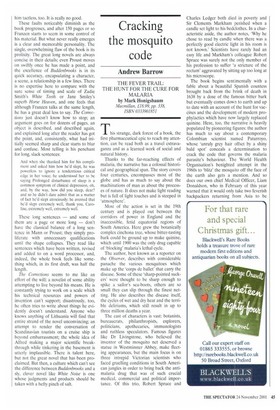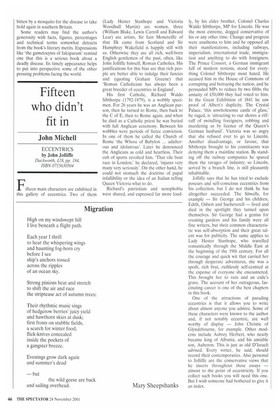Cracking the mosquito code
Andrew Barrow
THE FEVER TRAIL: THE HUNT FOR THE CURE FOR MALARIA by Mark Honigsbaum
Macmillan, £18.99, pp. 338, ISBN 0333901851
This strange, dark forest of a book, the first pharmaceutical epic to reach my attention, can be read both as a travel extravaganza and as a learned work of social and natural history.
Thanks to the far-reaching effects of malaria, the narrative has a colossal historical and geographical span. The story covers four centuries, encompasses most of the globe and has as much to say about the machinations of man as about the processes of nature. It does not make light reading but is full of light touches and is steeped in 'atmosphere'.
Most of the action is set in the 19th century and is played out between the corridors of power in England and the inaccessible, fetid equatorial regions of South America. Here grew the botanically complex cinchona tree, whose bitter-tasting bark could be ground up to make quinine, which until 1900 was the only drug capable of 'blocking' malaria's lethal cycle.
The author, best known as a reporter on the Observer, describes with considerable panache the various mosquitoes which make up the 'corps de ballet' that carry the disease. Some of these 'sharp-pointed suckers' were thought to be sharp enough to spike a sailor's sea-boots, others are so small they can slip through the finest netting. He also describes the disease itself, the cycles of wet and dry heat and the terrible deliriums, which still result in up to three million deaths a year.
The cast of characters is vast: botanists, bureaucrats, philanthropists, explorers, politicians, apothecaries, immunologists and ruthless speculators. Famous figures like Dr Livingstone, who believed the inventor of the mosquito net deserved a statue in Westminster Abbey, make fleeting appearances, but the main focus is on three intrepid Victorian scientists who faced gruelling conditions in South American jungles in order to bring back the antimalaria drug that was of such crucial medical, commercial and political importance. Of this trio, Robert Spruce and
Charles Ledger both died in poverty and Sir Clements Markham perished when a candle set light to his bedclothes. In a characteristic aside, the author notes, 'Why he chose to read by candle when there was a perfectly good electric light in his room is not known.' Scientists have rarely had an easy life and Markham's colleague Robert Spruce was surely not the only member of his profession to suffer 'a stricture of the rectum' aggravated by sitting up too long at his microscope.
The book begins sentimentally with a fable about a beautiful Spanish countess brought back from the brink of death in 1638 by a dose of the famous bitter bark but eventually comes down to earth and up to date with an account of the hunt for vaccines and the development of modern prophylactics which have now largely replaced quinine. Here, too, the narrative is heavily populated by pioneering figures: the author has much to say about a contemporary Colombian scientist named Patarroyo, whose 'unruly grey hair offset by a shiny bald spot' conceals a determination to crack the code that governs the malaria parasite's behaviour. The World Health Organisation's benighted attempt in the 1960s to 'blitz' the mosquito off the face of the earth also gets a mention. And so does our own chief Medical Officer, Liam Donaldson, who in February of this year warned that it would only take two feverish backpackers returning from Asia to be
bitten by a mosquito for the disease to take hold again in southern Britain.
Some readers may find the author's generosity with facts, figures, percentages and technical terms somewhat detracts from the book's literary merits. Expressions like 'the gametocytes of falciparum' remind one that this is a serious book about a deadly disease. Its timely appearance helps to put into perspective some of the other pressing problems facing the world.



















































































 Previous page
Previous page